Southern pine beetles destroying swaths of Long Island forests, 'largest threat' to Suffolk preserved land
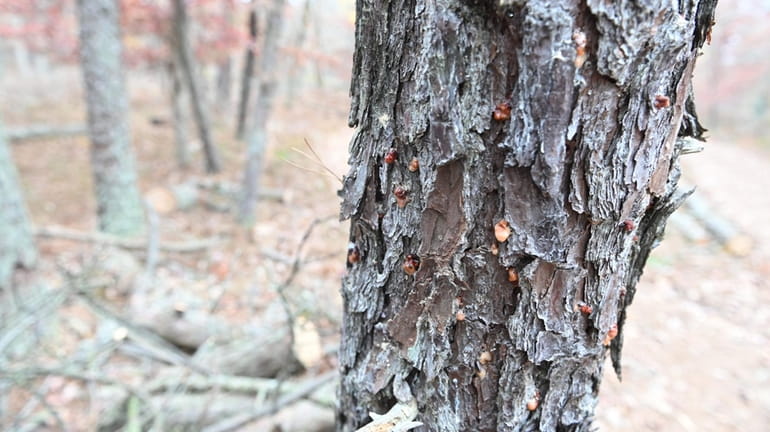
Many of the once-green pine trees along roadways in Suffolk County have turned yellow and orange, evidence that they are dying.
They're victims of the southern pine beetle, an invasive insect no larger than a grain of rice, that ecologists say currently is the biggest threat to Long Island’s pine barrens.
Forestry experts said they have seen an increase in southern pine beetle activity, particularly over the past two years, fueled by warmer winters, a drought in 2022 and dense woodlands, where trees compete for water, sunlight and nutrients.
“The beetle population and infestation is at a severe enough level where they are starting to grow in an exponential way, and it is more noticeable," said Nathan Hudson, southern pine beetle program coordinator for the state Department of Environmental Conservation. “It has done that this summer, especially on the South Fork.”
Napeague State Park in East Hampton, Southaven County Park in Yaphank and lands around Brookhaven National Lab in Upton are just some of the places the beetles have infested, killing countless trees over the last year — mostly pitch pine and white pines.
Since it appeared on Long Island in 2014, the beetle has destroyed approximately 5,000 acres, including an estimated 800 this year, according to the DEC. It has cut swaths through an ecosystem that is home to dozens of animals and plants, including endangered species. Large portions of the pine barrens have been set aside to preserve clean drinking water.
The beetle, Dendroctonus frontalis, is native to the southeastern United States but has been moving north, likely due to warmer winters, officials said. Ecologists in New Jersey, which has a Pinelands National Reserve that tops 1 million acres, have been battling it for more than 20 years.
While the beetle has also been spotted in Nassau County, experts said it is less of a threat there because there are no large pitch pine forests.
Adult beetles burrow into trees, entering through cracks in the bark. They dig tunnels into the tree trunks and leave eggs in their path. If the infestation is large enough, the tree will not be able to get the water and nutrients it needs to survive. Healthy trees are able to use resin they secrete to battle the beetles, but can be overwhelmed by thousands of them.
“They can move across an entire forest in a single growing season,” Hudson said.
The state has been using different management techniques, including thinning some of the forests and controlled burns, in an effort to slow the beetle’s damage. Since 2015, the DEC has cut down an estimated 37,000 infested pine trees on Long Island, officials said.
Removing dead and sick trees also gives new trees a better chance of survival
Last week, John Wernet, supervising forester for the division of lands and forests for DEC Region 1 (covering Nassau and Suffolk counties), and Chris Steigerwald, ecological field specialist for the Central Pine Barrens Commission, walked through a portion of Henry’s Hollow Pine Barrens State Forest in East Quogue, where infested and unhealthy trees were cut down nine years ago.
Piles of fallen trees and cut logs line the sandy walking path. But just a few feet away, several young green pitch pines appeared to be thriving.
“You can see the regeneration coming in,” Steigerwald said, standing near small pine trees. “This is exactly what we look for.”
The scene was much more grim at Southaven County Park in Yapank, site of an active infestation. The sprawling park is full of rust-colored dead pine trees. Evidence of the beetle is everywhere — in the blue-green fungus seen on the stumps, tiny pin holes in the bark and popcorn-shaped blobs of resin surrounding the trees.
Local environmental groups said saving the pine barrens is important for several reasons.
“It’s just an ecological treasure trove, a really novel type of forest from either a regional or global perspective,” said John Turner, board member of the Long Island Pine Barrens Society.
Turner said the greatest concentration of rare plants and animals in the state can be found in the Long Island pine barrens. Some of those include the buck moth, eastern mud turtle, eastern tiger salamander and northern harrier hawk.
“It overlies the largest supply of clean water on Long Island,” he said, referring to the deep aquifer system under the pine barrens. “This is a fact not lost on key decision-makers.”
Long Island’s pine barrens stretch across a mix of federal, state, county and privately owned lands. In 1993, the Long Island Pine Barrens Protection Act created the 100,000-acre plus Central Pine Barrens region, which includes parts of Brookhaven, Riverhead and Southampton towns. More than half of that region is set aside for preservation.
The most serious threat to that preservation arrived in the fall of 2014, when the southern pine beetle was discovered in the Wertheim National Wildlife Refuge in Shirley.
Since that time, the DEC has conducted surveillance on the ground and in the air to track the beetle’s path, Wernet said. That helps guide where the state can focus its efforts to suppress the infestation.
“These beetles are so successful because they release pheromones,” Wernet said. “It’s pretty much the dinner bell that brings all the beetles in. When you cut down those trees, you disrupt those pheromones. The beetles are confused and don't know quite where to go. It really slows down the infestation.”
Creating more space between trees also eliminates competition for water, nutrients and sunlight on a crowded forest floor and allows stronger trees to develop.
“One beetle, even 100 beetles, can’t kill a tree,” Hudson said. “You have to have hundreds of thousands of beetles in order to really have an active infestation. By thinning the forest, you disrupt that pheromone communication and infestations fizzle out.”
Steigerwald said 2022 was one of the worst drought years in almost 25 years, making it even more difficult for trees to fight off the beetle.
“I was seeing trees with such a lack of resources, they weren’t able to defend themselves anymore,” he said. “It was one of the worst years for tree mortality for southern pine beetle attacks.”
The warmer winters are keeping the beetle active longer, he said.
“They are not really stopping anymore,” Steigerwald said. “They are kind of continuing year-round and just continue to take pine trees as they go.”
Turner said he doesn't think the beetle will wipe out Long Island's pine trees, but he does think it will have a lasting effect on the forests.
"I think that the species will become more and more integrated in the system through time, and its impact on pine will diminish," he said. "If that does happen, what we will see is a shift from pine barrens to a forest more dominated by oaks and perhaps other deciduous trees and less pitch pine."
Wernet said, “In the pine barrens, this is the largest threat we have. … We are never going to stop it, but we are going to try to slow it down and protect what’s left.”
Many of the once-green pine trees along roadways in Suffolk County have turned yellow and orange, evidence that they are dying.
They're victims of the southern pine beetle, an invasive insect no larger than a grain of rice, that ecologists say currently is the biggest threat to Long Island’s pine barrens.
Forestry experts said they have seen an increase in southern pine beetle activity, particularly over the past two years, fueled by warmer winters, a drought in 2022 and dense woodlands, where trees compete for water, sunlight and nutrients.
“The beetle population and infestation is at a severe enough level where they are starting to grow in an exponential way, and it is more noticeable," said Nathan Hudson, southern pine beetle program coordinator for the state Department of Environmental Conservation. “It has done that this summer, especially on the South Fork.”
WHAT TO KNOW
- There has been an increase in the number of Long Island pine trees killed by the southern pine beetle.
- State officials are trying to control the spread and save the forests that remain by conducting surveillance and removing dead and sick trees.
- Some experts believe the southern pine beetle could change the composition of the Pine Barrens over time.
Napeague State Park in East Hampton, Southaven County Park in Yaphank and lands around Brookhaven National Lab in Upton are just some of the places the beetles have infested, killing countless trees over the last year — mostly pitch pine and white pines.
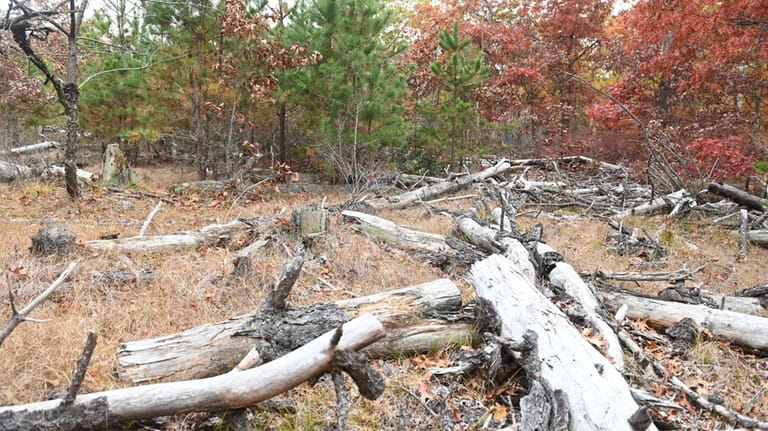
Southern pine beetles have destroyed 5,000 acres since discovered on Long Island in 2014, including at Henrys Hollow Pine Barren State Forest. Credit: John Roca
Since it appeared on Long Island in 2014, the beetle has destroyed approximately 5,000 acres, including an estimated 800 this year, according to the DEC. It has cut swaths through an ecosystem that is home to dozens of animals and plants, including endangered species. Large portions of the pine barrens have been set aside to preserve clean drinking water.
The beetle, Dendroctonus frontalis, is native to the southeastern United States but has been moving north, likely due to warmer winters, officials said. Ecologists in New Jersey, which has a Pinelands National Reserve that tops 1 million acres, have been battling it for more than 20 years.
While the beetle has also been spotted in Nassau County, experts said it is less of a threat there because there are no large pitch pine forests.
Swaths of destruction, but regeneration efforts
Adult beetles burrow into trees, entering through cracks in the bark. They dig tunnels into the tree trunks and leave eggs in their path. If the infestation is large enough, the tree will not be able to get the water and nutrients it needs to survive. Healthy trees are able to use resin they secrete to battle the beetles, but can be overwhelmed by thousands of them.
“They can move across an entire forest in a single growing season,” Hudson said.
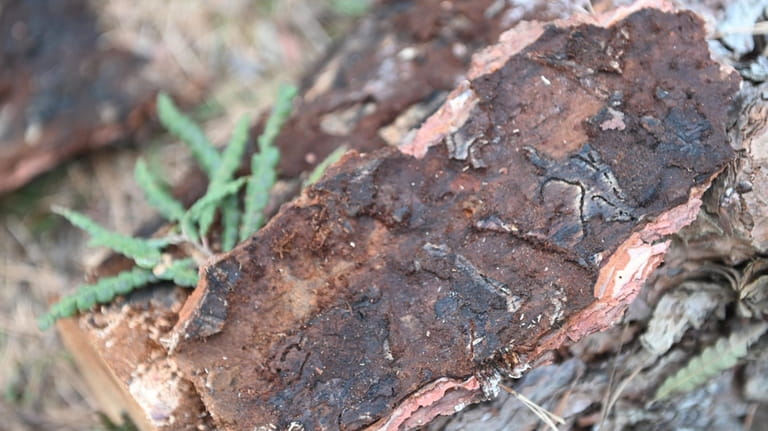
Dead pine trees at Southaven County Park. Adult beetles dig tunnels into trunks and leave eggs in their paths. Credit: John Roca
The state has been using different management techniques, including thinning some of the forests and controlled burns, in an effort to slow the beetle’s damage. Since 2015, the DEC has cut down an estimated 37,000 infested pine trees on Long Island, officials said.
Removing dead and sick trees also gives new trees a better chance of survival
Last week, John Wernet, supervising forester for the division of lands and forests for DEC Region 1 (covering Nassau and Suffolk counties), and Chris Steigerwald, ecological field specialist for the Central Pine Barrens Commission, walked through a portion of Henry’s Hollow Pine Barrens State Forest in East Quogue, where infested and unhealthy trees were cut down nine years ago.
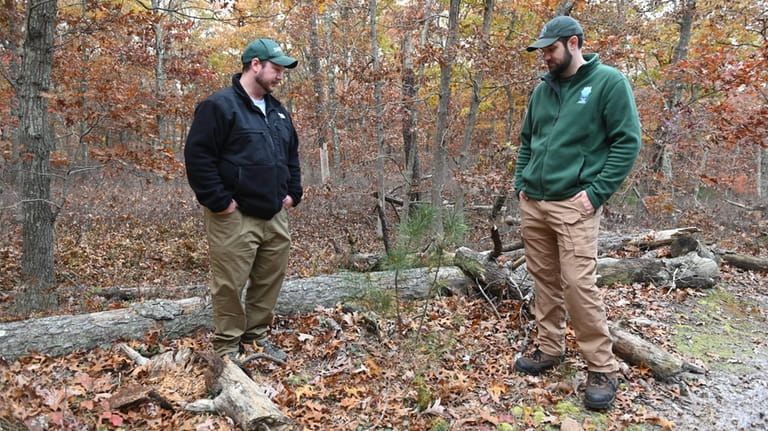
John Wernet, left, and Chris Steigerwald examine dead pine trees and new growth at Henry’s Hollow Pine Barrens State Forest in East Quogue. Credit: John Roca
Piles of fallen trees and cut logs line the sandy walking path. But just a few feet away, several young green pitch pines appeared to be thriving.
“You can see the regeneration coming in,” Steigerwald said, standing near small pine trees. “This is exactly what we look for.”
The scene was much more grim at Southaven County Park in Yapank, site of an active infestation. The sprawling park is full of rust-colored dead pine trees. Evidence of the beetle is everywhere — in the blue-green fungus seen on the stumps, tiny pin holes in the bark and popcorn-shaped blobs of resin surrounding the trees.
Pine barrens an 'ecological treasure trove'
Local environmental groups said saving the pine barrens is important for several reasons.
“It’s just an ecological treasure trove, a really novel type of forest from either a regional or global perspective,” said John Turner, board member of the Long Island Pine Barrens Society.
Turner said the greatest concentration of rare plants and animals in the state can be found in the Long Island pine barrens. Some of those include the buck moth, eastern mud turtle, eastern tiger salamander and northern harrier hawk.
“It overlies the largest supply of clean water on Long Island,” he said, referring to the deep aquifer system under the pine barrens. “This is a fact not lost on key decision-makers.”
Long Island’s pine barrens stretch across a mix of federal, state, county and privately owned lands. In 1993, the Long Island Pine Barrens Protection Act created the 100,000-acre plus Central Pine Barrens region, which includes parts of Brookhaven, Riverhead and Southampton towns. More than half of that region is set aside for preservation.
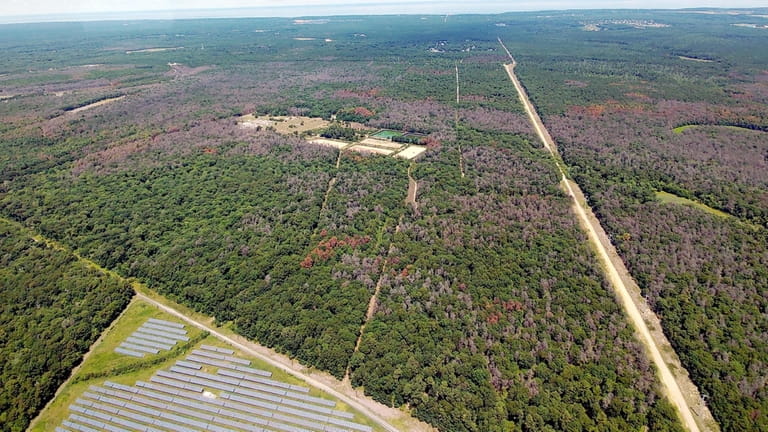
Dead and dying pine trees among living trees near Brookhaven National Lab, shown on Aug. 2. Credit: Courtesy NYS DEC
The most serious threat to that preservation arrived in the fall of 2014, when the southern pine beetle was discovered in the Wertheim National Wildlife Refuge in Shirley.
Since that time, the DEC has conducted surveillance on the ground and in the air to track the beetle’s path, Wernet said. That helps guide where the state can focus its efforts to suppress the infestation.
“These beetles are so successful because they release pheromones,” Wernet said. “It’s pretty much the dinner bell that brings all the beetles in. When you cut down those trees, you disrupt those pheromones. The beetles are confused and don't know quite where to go. It really slows down the infestation.”
Creating more space between trees also eliminates competition for water, nutrients and sunlight on a crowded forest floor and allows stronger trees to develop.
“One beetle, even 100 beetles, can’t kill a tree,” Hudson said. “You have to have hundreds of thousands of beetles in order to really have an active infestation. By thinning the forest, you disrupt that pheromone communication and infestations fizzle out.”
2022 'one of the worst years'
Steigerwald said 2022 was one of the worst drought years in almost 25 years, making it even more difficult for trees to fight off the beetle.
“I was seeing trees with such a lack of resources, they weren’t able to defend themselves anymore,” he said. “It was one of the worst years for tree mortality for southern pine beetle attacks.”
The warmer winters are keeping the beetle active longer, he said.
“They are not really stopping anymore,” Steigerwald said. “They are kind of continuing year-round and just continue to take pine trees as they go.”
Turner said he doesn't think the beetle will wipe out Long Island's pine trees, but he does think it will have a lasting effect on the forests.
"I think that the species will become more and more integrated in the system through time, and its impact on pine will diminish," he said. "If that does happen, what we will see is a shift from pine barrens to a forest more dominated by oaks and perhaps other deciduous trees and less pitch pine."
Wernet said, “In the pine barrens, this is the largest threat we have. … We are never going to stop it, but we are going to try to slow it down and protect what’s left.”

